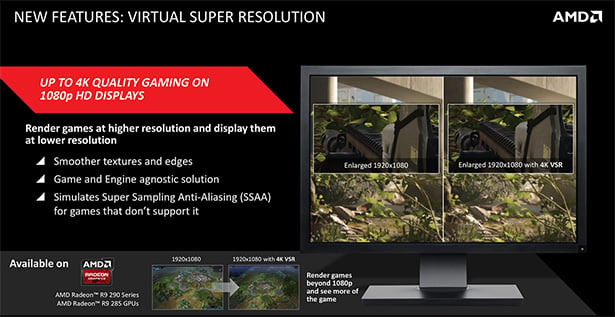AMD Brings Increased Performance, Over 20 New Features With Catalyst Omega Drivers
AMD this week delivered its Catalyst Omega drivers that are the culmination of six months of development work. AMD Catalyst Omega brings over 20 new features, a wealth of bug fixes to the table along with performance increases both on AMD Radeon GPUs and integrated AMD APUs.
Some of the new functionality brought with the Catalyst Omega driver includes Virtual Super Resolution, or VSR. VSR is essentially AMD's answer to NVIDIA's DSR, or Dynamic Super Resolution. VSR is “game- and engine-agnostic” and renders content at up to 4K resolution, then displays it at a resolution your monitor actually supports. The very nature of VSR allows it to be used across a wide spectrum of applications including games and even the Windows desktop.
AMD says that VSR allows for increased image quality, similar in concept to Super Sampling Anti-Aliasing (SSAA). Another added perk of VSR is the ability to see more content on the screen at once, as seen by the sample image below:
To take advantage of VSR, you’ll need a Radeon R9 295X2, R9 290X, R9 290, or R9 285 discrete graphics card. Both single- and multi-GPU configurations are currently supported with VSR, and the following resolutions are currently supported:
VSR can be enabled from within the driver control panel. Once enabled, gamers simply have to select the higher resolution mode from within the game’s display settings menu.
Another big new feature comes in the form of enhancements to frame-pacing. As AMD explains, such technology has already been introduced for gamers with Crossfire graphics configurations, but Catalyst Omega enables the tech on systems that use the onboard AMD APU in conjunction with a discrete Radeon GPU.
This wouldn’t be a new Catalyst release without performance enhancements, and those are definitely in the cards with AMD Catalyst Omega. AMD cites as little as a 6 percent improvement in performance on FIFA Online and as much as a 29 percent increase in Batman Arkham Origins when using an AMD 7000-Series APU (comparing Catalyst 14.2 to Catalyst Omega 14.5).
On discrete GPUs — in this case, an AMD Radeon R9 290X — the performance increases ranged from 8 percent in Grid 2 to roughly 16 percent in Bioshock Infinity (Catalyst 13.12 versus Catalyst Omega 14.501).
Other additions include AMD Fluid Video, which smoothes out Blu-ray playback on lower power APUs and helps to remove video judder. Contour Removal helps to remove artifacts from compressed videos without wiping out finer details. AMD is also introducing the capability to improve the appearance of 1080p content on your 4K and higher resolution monitors in addition to improving the clarity and sharpness of low resolution content on 1080p displays.
Support has also been added in the Catalyst Omega drivers for the Alienware Graphics Amplifier. If you recall, the Graphics Amplifier was announced back in late October alongside the new Alienware 13 gaming notebook. The 7.7-pound external graphics solution allows you to plug in up to one, dual-slot video card inside. The Graphics Amplifier can tap directly into your notebook’s PCI Express interface using a proprietary external cable, but it will only work with Alienware notebooks (currently limited to just the Alienware 13).
When using the Graphics Amplifier (with a Radeon R9 290X onboard) instead of the built-in NVIDIA GeForce GTX 860M GPU onboard the Alienware 13, AMD was able to witness a 269 percent increase in performance in Sniper Elite when running at 1440p (Ultra Quality).
Additional hardware support is also fully baked into the Catalyst Omega drivers, including support for up to 24 monitors using Eyefinity and 5K panel support.
You can head over to the AMD driver download page to grab the Catalyst Omega drivers.







